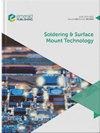Flow behavior during solder/Cu column friction plunge micro-welding
IF 1.8
4区 材料科学
Q3 ENGINEERING, ELECTRICAL & ELECTRONIC
引用次数: 0
Abstract
Purpose The author proposed a friction plunge micro-welding (FPMW) method and applied it to column grid array packaging to realize the connection of copper columns without precision molds assisted positioning. The purpose of this paper is to study the flow behavior of the solder undergoing frictional thermo-mechanical action during the FPMW and to determine the source of the solders in the micro-zones with different microstructure characteristics near the solder/Cu column friction interface. Design/methodology/approach Three kinds of Sn58Bi/SAC305 and SAC305/Pb90Sn composite solder samples were designed to study the flow behavior of the solder during FPMW using Bi and Pb as tracer elements. Findings The results show that most of the solders in the position occupied by the copper column was softened and plasticized during the welding process and was extruded to side of the copper column, flowing axially, circumferentially and radially along a trajectory similar to a conical spiral line. Under the drive of the tangential friction force and the radial hold-tight force, the extruded out visco-plastic solders fully mixed with the visco-plastic solders on the sides of the copper column, and bonded with the solders that deformed plastically on the periphery, so that a stir zone and a dynamic recrystallization zone finally evolved. The outside plastically deformed solders evolved into a thermo-mechanical affected zone. Originality/value The flow behavior of the solder during the FPMW was determined, as well as the source of the solders in micro-zones with different microstructure characteristics.焊料/铜柱摩擦微焊接流动特性研究
目的提出一种摩擦骤降微焊接(FPMW)方法,并将其应用于柱栅阵列封装中,实现铜柱的连接,无需精密模具辅助定位。本文的目的是研究FPMW过程中受摩擦热机械作用的焊料的流动行为,并确定焊料/铜柱摩擦界面附近具有不同微观结构特征的微区中焊料的来源。设计了3种Sn58Bi/SAC305和SAC305/Pb90Sn复合焊料样品,以Bi和Pb为示踪元素,研究了FPMW过程中焊料的流动行为。结果表明:铜柱所占位置的焊料在焊接过程中大部分被软化塑化,并被挤压到铜柱侧面,沿类似锥形螺旋线的轨迹向轴向、向周向和向径向流动;在切向摩擦力和径向抱紧力的驱动下,挤出的粘塑性焊料与铜柱两侧的粘塑性焊料充分混合,并与外围发生塑性变形的焊料结合,最终形成搅拌区和动态再结晶区。外部塑性变形的焊料演变成热机械影响区。确定了FPMW过程中焊料的流动行为,以及具有不同微观结构特征的微区焊料的来源。
本文章由计算机程序翻译,如有差异,请以英文原文为准。
求助全文
约1分钟内获得全文
求助全文
来源期刊

Soldering & Surface Mount Technology
工程技术-材料科学:综合
CiteScore
4.10
自引率
15.00%
发文量
30
审稿时长
>12 weeks
期刊介绍:
Soldering & Surface Mount Technology seeks to make an important contribution to the advancement of research and application within the technical body of knowledge and expertise in this vital area. Soldering & Surface Mount Technology compliments its sister publications; Circuit World and Microelectronics International.
The journal covers all aspects of SMT from alloys, pastes and fluxes, to reliability and environmental effects, and is currently providing an important dissemination route for new knowledge on lead-free solders and processes. The journal comprises a multidisciplinary study of the key materials and technologies used to assemble state of the art functional electronic devices. The key focus is on assembling devices and interconnecting components via soldering, whilst also embracing a broad range of related approaches.
 求助内容:
求助内容: 应助结果提醒方式:
应助结果提醒方式:


